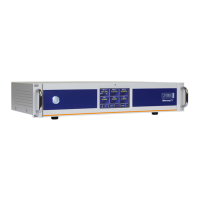MercuryiTC
©2014 Oxford Instruments Omicron NanoScience. All rights reserved.
Page 70
5 CRYOGEN LEVEL-METER
The level of cryogen in a reservoir can be measured using the level-meter board. The board can
be used with liquid helium and liquid nitrogen systems. The level-meter raises an error if the
cryogen level falls below a safe level.
The level-meter board uses a superconducting-wire probe to measure the depth of liquid
helium, or a capacitance probe to detect the level of liquid nitrogen.
There are two 9-way D connectors on the board; one for a nitrogen sensor and one for a helium
sensor.
5.1 Principles of operation
5.1.1 Operation of the board with a helium-level probe
The probe is a length of superconducting wire extending from the bottom to the top of the
helium reservoir. The probe is normally mounted vertically, although other geometries are
possible.
The section of wire below the liquid surface is cooled more efficiently than the section in the gas
above the liquid. The level-meter controls the current through the wire such that the temperature
of the section in the gas is above the critical temperature (and is thus resistive), while the
section in the liquid is below the critical temperature (and thus superconducting). The length of
the resistive section of the wire thus depends on the level of liquid in the reservoir.
To minimise heating of the sample, the current in the wire is turned off after a measurement has
been made. Because there is zero current through the probe, the whole length of wire becomes
superconducting between measurements. When the next measurement is made, it is necessary
to introduce heat into the section of wire in the gas to make it resistive. A small heater-resistor is
mounted in thermal contact with the top of the wire to heat a small section of wire. If the current
in the wire is sufficient, the resistive section propagates down the wire until it extends to the
surface of the liquid.
When the measurement has been made, the current in the wire is turned off again. The
measurement is performed at intervals between a few second to a few hours, depending on the
expected rate of change of the liquid level. Do not perform measurements too often, as each

